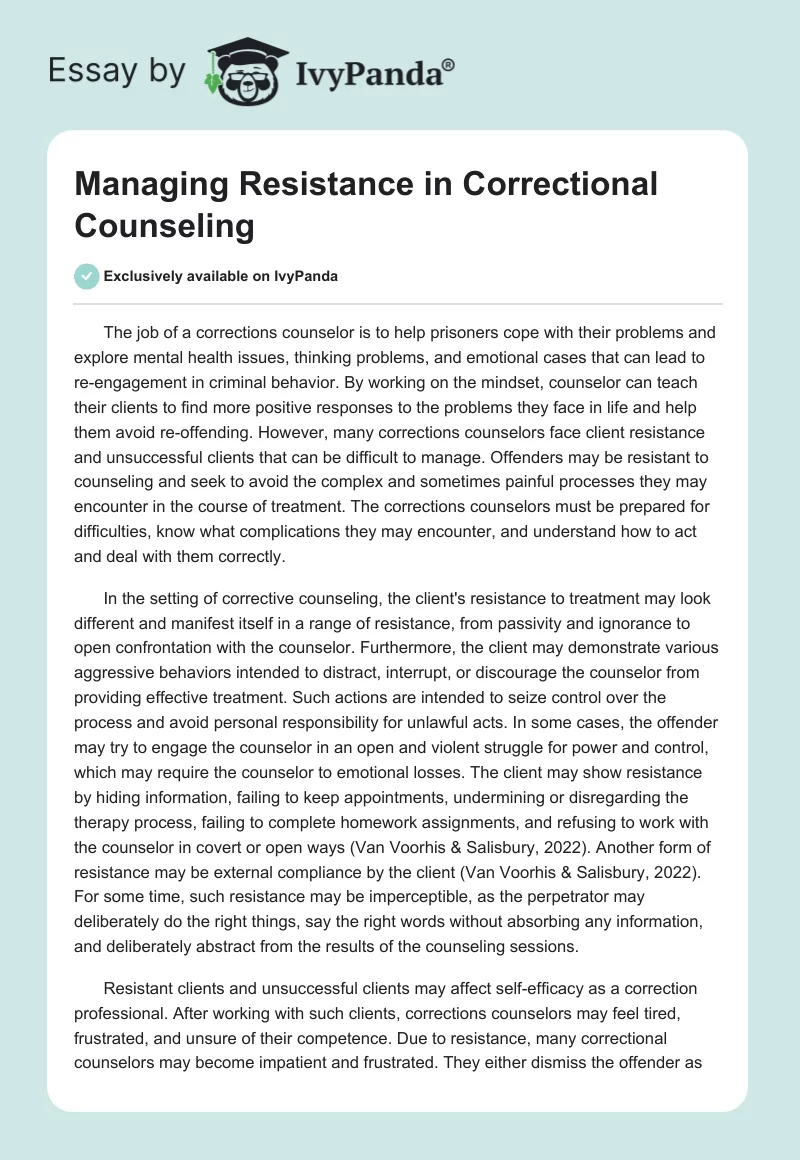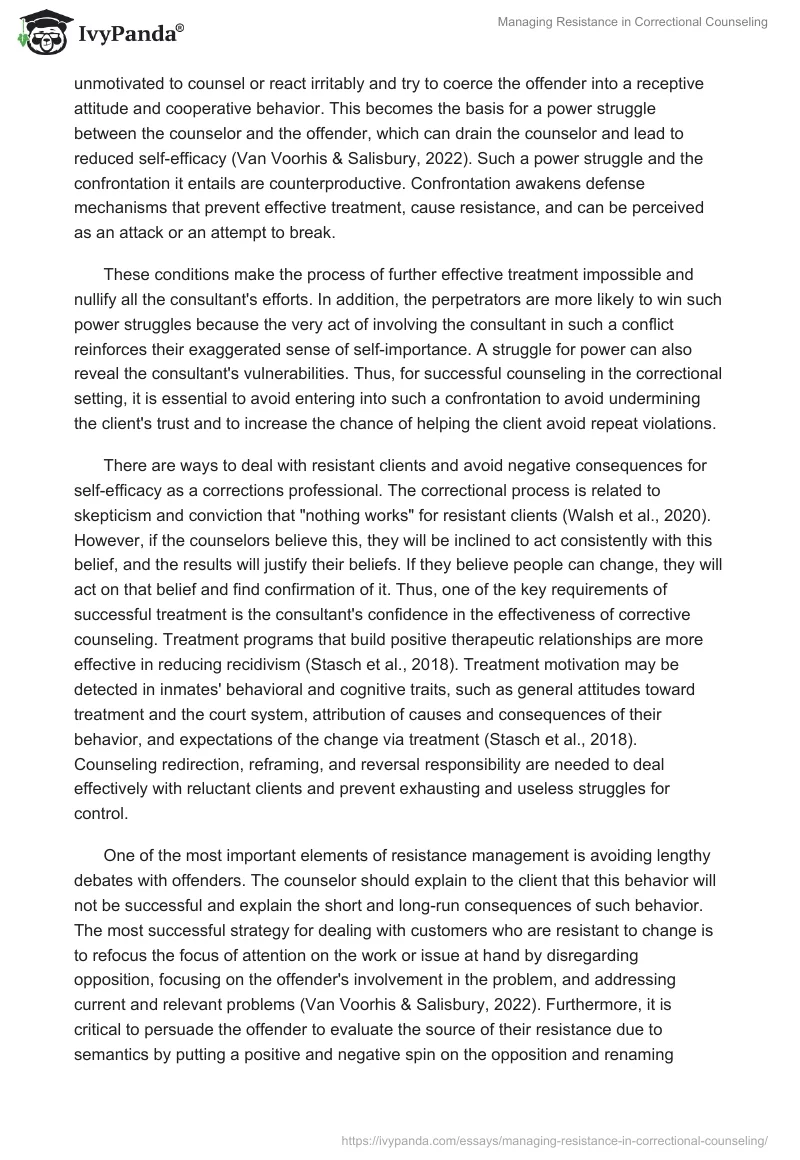The job of a corrections counselor is to help prisoners cope with their problems and explore mental health issues, thinking problems, and emotional cases that can lead to re-engagement in criminal behavior. By working on the mindset, counselor can teach their clients to find more positive responses to the problems they face in life and help them avoid re-offending. However, many corrections counselors face client resistance and unsuccessful clients that can be difficult to manage. Offenders may be resistant to counseling and seek to avoid the complex and sometimes painful processes they may encounter in the course of treatment. The corrections counselors must be prepared for difficulties, know what complications they may encounter, and understand how to act and deal with them correctly.
In the setting of corrective counseling, the client’s resistance to treatment may look different and manifest itself in a range of resistance, from passivity and ignorance to open confrontation with the counselor. Furthermore, the client may demonstrate various aggressive behaviors intended to distract, interrupt, or discourage the counselor from providing effective treatment. Such actions are intended to seize control over the process and avoid personal responsibility for unlawful acts. In some cases, the offender may try to engage the counselor in an open and violent struggle for power and control, which may require the counselor to emotional losses. The client may show resistance by hiding information, failing to keep appointments, undermining or disregarding the therapy process, failing to complete homework assignments, and refusing to work with the counselor in covert or open ways (Van Voorhis & Salisbury, 2022). Another form of resistance may be external compliance by the client (Van Voorhis & Salisbury, 2022). For some time, such resistance may be imperceptible, as the perpetrator may deliberately do the right things, say the right words without absorbing any information, and deliberately abstract from the results of the counseling sessions.
Resistant clients and unsuccessful clients may affect self-efficacy as a correction professional. After working with such clients, corrections counselors may feel tired, frustrated, and unsure of their competence. Due to resistance, many correctional counselors may become impatient and frustrated. They either dismiss the offender as unmotivated to counsel or react irritably and try to coerce the offender into a receptive attitude and cooperative behavior. This becomes the basis for a power struggle between the counselor and the offender, which can drain the counselor and lead to reduced self-efficacy (Van Voorhis & Salisbury, 2022). Such a power struggle and the confrontation it entails are counterproductive. Confrontation awakens defense mechanisms that prevent effective treatment, cause resistance, and can be perceived as an attack or an attempt to break.
These conditions make the process of further effective treatment impossible and nullify all the consultant’s efforts. In addition, the perpetrators are more likely to win such power struggles because the very act of involving the consultant in such a conflict reinforces their exaggerated sense of self-importance. A struggle for power can also reveal the consultant’s vulnerabilities. Thus, for successful counseling in the correctional setting, it is essential to avoid entering into such a confrontation to avoid undermining the client’s trust and to increase the chance of helping the client avoid repeat violations.
There are ways to deal with resistant clients and avoid negative consequences for self-efficacy as a corrections professional. The correctional process is related to skepticism and conviction that “nothing works” for resistant clients (Walsh et al., 2020). However, if the counselors believe this, they will be inclined to act consistently with this belief, and the results will justify their beliefs. If they believe people can change, they will act on that belief and find confirmation of it. Thus, one of the key requirements of successful treatment is the consultant’s confidence in the effectiveness of corrective counseling. Treatment programs that build positive therapeutic relationships are more effective in reducing recidivism (Stasch et al., 2018). Treatment motivation may be detected in inmates’ behavioral and cognitive traits, such as general attitudes toward treatment and the court system, attribution of causes and consequences of their behavior, and expectations of the change via treatment (Stasch et al., 2018). Counseling redirection, reframing, and reversal responsibility are needed to deal effectively with reluctant clients and prevent exhausting and useless struggles for control.
One of the most important elements of resistance management is avoiding lengthy debates with offenders. The counselor should explain to the client that this behavior will not be successful and explain the short and long-run consequences of such behavior. The most successful strategy for dealing with customers who are resistant to change is to refocus the focus of attention on the work or issue at hand by disregarding opposition, focusing on the offender’s involvement in the problem, and addressing current and relevant problems (Van Voorhis & Salisbury, 2022). Furthermore, it is critical to persuade the offender to evaluate the source of their resistance due to semantics by putting a positive and negative spin on the opposition and renaming resistance based on the underlying criminal thinking pattern. It is critical to reflect the offender’s resistance in a way that assigns personal responsibility and demands by paraphrasing resistance while paying attention to its underlying meaning, asking challenging and open-ended questions, encouraging the offender to make a value judgment of resistance, and delivering responses as tentative observations.
References
Stasch, J., Yoon, D., Sauter, J., Hausam, J., & Dahle, K. P. (2018). Prison climate and its role in reducing dynamic risk factors during offender treatment. International journal of offender therapy and comparative criminology, 62(14), 4609-4621. Web.
Van Voorhis, P. Salisbury, E. J. (2022). Correctional counseling and rehabilitation (10th ed.). Routledge.
Walsh, A., Wells, J., & Gann, S. M. (2020). Directive counseling: Theory and practice. In A. Walsh, J. Wells, S. M. (Eds.), Gann Correctional assessment, casework, and counseling (pp. 153-175). Springer.


